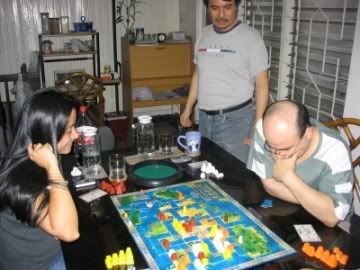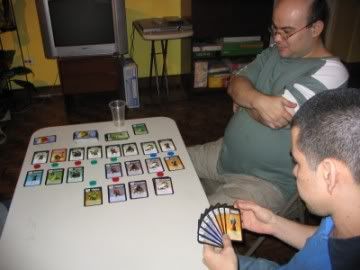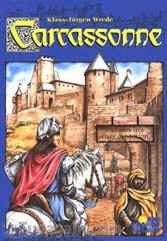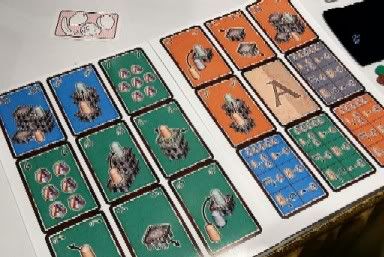Before I begin, I’d like to set the tone for this game. In Amun-Re, players assume the roles of Pharaohs, Great Men who led the people of Egypt in the development of civilization. Under their leadership, the Nile was tamed to feed Egypt, and great pyramids were erected at their behest. This game is their story.
Now, you must read the story of five of these Great Men before we proceed. Follow
this link, then return when you have finished.
Back? Good.
I trust that Golakhamen has whetted your appetite to journey to ancient Egypt. Let’s talk about the game.

Amun-Re is Reiner Knizia’s first serious strategy game since the amazing Euphrat & Tigris. Just like E&T, Amun-Re was developed and published by Hans im Gluck, and that practically guarantees very high production values. The game comes in a HiG big box, similar to E&T. Its board, an abstraction of the various provinces of Egypt, is of the four-fold linen-finished variety. The design includes many icons that aid in gameplay, giving the board great utility in addition to being beautiful. This being a game about Egypt and its competing Pharaohs, a bunch of cool little resin pyramids comes with the game. In addition, there are resin pieces that look like Chiclets in the color of the pyramids, representing building stones. Five sets of twin Chiclets in the player colors round out the plastic pieces. The game’s counters are thick cardboard, including stand-up figures of a temple and a Pharaoh. Finally, the game sports a bunch of small linen-finished cards, which includes the game’s currency.
As you can tell, the game presentation is outstanding, which is not surprising coming from Hans im Gluck.
The GamePlayers are Pharaohs vying for the favor of the god Amun-Re, with the goal of being known as the greatest dynasty to lead the Egyptians. The twist here is that players are not individual Pharaohs. All the Pharaohs who begin the game perish midway through, and their descendants carry on in the second stanza of this two-part drama. In Egypt, onlt the pyramids withstand the ravages of time. Did I mention this game has a fantastic theme, and that theme is integrated closely with its mechanisms? Well, I have now.
The Egypt of Amun-Re has fifteen provinces. The provinces are either north or south of the Nile, upstream or downstream of the Nile, and are either along the banks of the Nile or not. The Nile is hugely important. Provinces along the Nile are fertile, and can be tilled by farmers. Each of these provinces can accept farmers in various numbers. The provinces that are not along the banks of the Nile can’t accept as many farmers, but may be frequented by camel caravans who trade with them. However, the caravans only deem it worthwhile to visit when Egypt has not had a bountiful harvest.
In addition to their Nile-driven attributes, provinces have inherent resources, such as bountiful building stones, valuables such as precious metals or gems that provide steady income, strong ties to Amun-Re which provide favors from the god, or standing temples to Amun-Re. Players must take all of this into consideration.
The game is played over two Kingdoms, which take place hundreds of years apart. Each Kingdom is composed of three Ages.
The first Kingdom is known as the Old Kingdom. In this part of the game, the dynasties of the players are just beginning to lead the peoples of Egypt towards prosperity.
Each Age proceeds in the same manner. The first thing that players do is bid Gold to offer Amun-Re for the right to settle the provinces. A number of provinces equal to the number of players are available each Age. Bids are made in triangular numbers, and each bid must surpass the previous. In the first twist of many in Amun-Re, a player who has been outbid for a province cannot immediately increase his bid for the same province. He must bid elsewhere. Once each player has bid on a different province, the offerings to Amun-Re are accepted and players take possession of the provinces and all the inherent resources accompanying. Provinces are the most important part of the game, so great care must be taken when selecting a province. While a free province is good, there is usually a good reason that it is not desirable to the other Pharaohs.
The next step is the improvement of the provinces. Players spend Gold to support farmers and purchase seed to grow crops, spend more Gold to support workers and purchase stone to raise pyramids, or spend even more Gold to spread the faith and curry favors from Amun-Re in the form of Power Cards. The second twist of the game is that the cost of each of the three resources increases in triangular fashion, and each type of resource can only be purchased in one batch in each Age. In addition, the provinces held by the player limit the number of farmers that may work in the fields, and the amount of favor that can be had via Power Cards.
Once development is completed, the communal Sacrifice to Amun-Re is held. While the god accepts starlings, asses’ milk and diet cola, Gold is the most important offering. The greater the offering, the more pleased Amun-Re is with Egypt as a whole, and with each Pharaoh as an individual. Each player secretly decides how much Gold to toss into the collection plate. Alternatively, a player may steal Gold from the plate to reduce the total offering. Offerings are revealed simultaneously, then tallied. If the total offering is great, then the harvest will be bountiful, and each farmer will harvest more crops and yield more Gold for their Pharaoh. If the total offering is crappy, then the harvest will be crummy the camel caravans will appear, and the provinces without fertile land will rejoice. Whatever the result of the communal Sacrifice, Amun-Re rewards the top contributor with three boons; the second best with two, and anyone else who did not steal from the offering with a single boon. A boon is a farmer, a building stone, or a favor as the Pharaoh may choose.
Finally, income is paid out to each Pharaoh based on the yield of each province following the results of the Sacrifice. Then, the second Age begins, and then the Third. At the end of the third Age, all the available provinces will have been awarded to the Pharaohs by Amun-Re. This signals the end of the Old Kingdom. Amun-Re awards the families of the Pharaohs for their deed with Points of Greatness. These are given for pyramids built in fashions pleasing to the god, for the state of the last harvest if the Pharaoh possesses provinces with temples, and for fulfilled dictates of Amun-Re as specified in certain Power Cards. Once these Points of Greatness are tallied, great sandstorms sweep across Egypt, wiping out everything on the board except for the pyramids.
Centuries pass, and Egyptian civilization regains its foothold along the Nile. The New Kingdom begins with the descendants of the original five Pharaohs. They inherit the wealth of their forefathers, and the First Age of the New Kingdom begins. Everything is as in the Old Kingdom, except that the provinces now bear the pyramids built by the ancestors of the new Pharaohs.
At the end of the Third Age of the New Kingdom, Points of Greatness are once again awarded by Amun-Re. Whichever of the players has the most Points is declared the Greatest Dynasty and is the winner of the game.
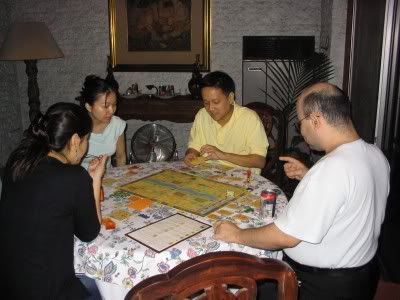 Strategy
StrategyAmun-Re begins and ends with the provinces. Players need to pay attention to which provinces are appearing, as this dynamic drives the Sacrifice, which is the main determinant of income. Cash is king (or rather, Pharaoh) in Amun-Re, as it allows a player to bid more for a desirable province, and to purchase more resources when he needs them. However, a player must ensure that he is getting a good return on his investments in farmers, Power Cards and Sacrifice offerings. It’s far too easy to spend money to buy a lot of farmers, and get crushed by the camel traders in the Sacrifice. Conversely, one might save money to drive the Sacrifice up, but not have enough farmers to make it worthwhile.
Be alert as to which players will benefit from a good harvest, and which will benefit from the camel traders coming in. This will allow you to predict the way the Sacrifice will go especially in the Second and Third Age, and you can bid on provinces accordingly. It is usually a good idea to grab fertile (farmer-heavy) provinces in the First Age, as your investment in farming will pay back three times. Steady income provinces which ignore the harvest are good acquisitions late in the Kingdom.
Power cards are usually good, but they are random. It’s not a bad idea to have the capability to acquire at least two in each Age, on the off chance that Amun-Re will ask you to make a pattern of pyramids or resources that you already have or are close to achieving in exchange for some Greatness. If you get the card in the Old Kingdom, you can try to fulfill it in the New Kingdom, but beware. Crafty opponents may spot the pattern you are trying to complete and foil you in the auction. (Yes, you can play defensively in Amun-Re, both in the province auction and in the Sacrifice.) Power cards can do fancy things, but they aren’t always useful. Good thing you can sell them to the market for one Gold anytime.
My advice is to go for a focused bonus in the Old Kingdom; the best one is usually having the most pyramids in one province on each side of the Nile. The bonus is pretty good, and it’s better than a set of pyramids in each of your provinces. Beware though that that province in all probability be hotly contested in the auction of the New Kingdom.
Reviewer’s TiltAmun-Re is a fabulous game for five players. With the full complement of Pharaohs, I’d give it a nine at the very least. However, its performance plummets with less than five players, as the balance of having all fifteen provinces in play is lost due to random elimination of three provinces per player not present. If by chance three camel caravan provinces are eliminated from play in a four player game, it sucks a lot of the tension out of Amun-Re. It’s still a decent game with four players, but it’s hardly remarkable. It suffers even more with only three, to the point that I’d no longer recommend playing the game. You just can’t guarantee any balance with just nine provinces in play. This is the main reason that I can only award Amun-Re an eight on the BGG scale.
Assuming that five participants can be mustered, this is one of the best German games available to being to the table, falling just short of the brilliance of The Princes of Florence. First, you have the awesome theme-to-mechanics relationship, which is just as strong as in Euphrat & Tigris. I can’t think of many other games with a theme this strong embedded into the gameplay and feel of the proceedings. Second, the decisions in the game are extremely tough, especially in the province auction. The triangular bids make each raise an extremely painful one, and the inability to remain in a province once overbid makes for a lot of agony. Third is the simple but effective use of a semi-blind bid in the Sacrifice. I hate the blind bidding mechanism, but used in this context it just makes sense. It’s not really blind either, since you can usually tell who’s going to swing which way just by looking at the provinces they hold. Finally, there are the little flourishes in the game that make it special. The little temples. The card backs for Power cards and money cards being identical. The ability to steal from the Sacrifice and being smited by Amun-Re for it. Crapping in your neighbor’s weaving hut then moving to Nineveh to play Euphrat & Tigris instead. (Okay, Gola made that last one up, but it’s still funny as hell.)
Amun-Re is arguably Knizia’s third-best strategy game behind E&T and Taj Mahal, but it’s his best game for five players. It’s arguably one of the three best German strategy games for five players, along with The Princes of Florence and Die Macher. If you’re able to muster five players the play German strategy games on a regular basis, Amun-Re is a game that you must have in your collection.


